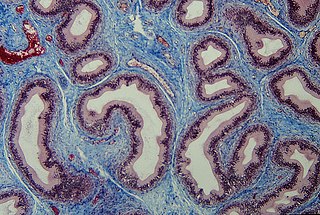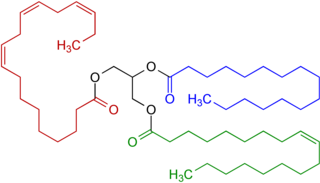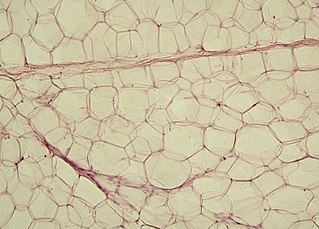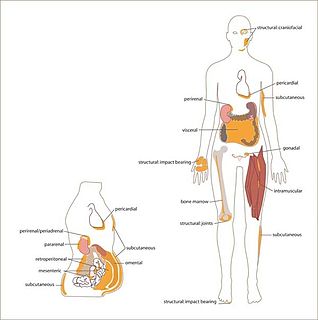
Connective tissue (CT) is one of the four basic types of animal tissue, along with epithelial tissue, muscle tissue, and nervous tissue. It develops from the mesoderm. Connective tissue is found in between other tissues everywhere in the body, including the nervous system. In the central nervous system, the three outer membranes that envelop the brain and spinal cord are composed of connective tissue. They support and protect the body. All connective tissue consists of three main components: fibers, ground substance and cells. Not all authorities include blood or lymph as connective tissue because they lack the fiber component. All are immersed in the body water.

Lipolysis is the metabolic pathway through which lipid triglycerides are hydrolyzed into a glycerol and three fatty acids. It is used to mobilize stored energy during fasting or exercise, and usually occurs in fat adipocytes. Lipolysis is induced by several hormones, including glucagon, epinephrine, norepinephrine, growth hormone, atrial natriuretic peptide, brain natriuretic peptide, and cortisol.

Carcinoma is a category of types of cancer that develop from epithelial cells. Specifically, a carcinoma is a cancer that begins in a tissue that lines the inner or outer surfaces of the body, and that arises from cells originating in the endodermal, mesodermal or ectodermal germ layer during embryogenesis.

Brown adipose tissue (BAT) or brown fat makes up the adipose organ together with white adipose tissue. Brown adipose tissue is found in almost all mammals.

Adipocytes, also known as lipocytes and fat cells, are the cells that primarily compose adipose tissue, specialized in storing energy as fat. Adipocytes are derived from mesenchymal stem cells which give rise to adipocytes through adipogenesis. In cell culture, adipocytes can also form osteoblasts, myocytes and other cell types.

Reduction mammoplasty is the plastic surgery procedure for reducing the size of large breasts. In a breast reduction surgery for re-establishing a functional bust that is proportionate to the woman's body, the critical corrective consideration is the tissue viability of the nipple-areola complex (NAC), to ensure the functional sensitivity and lactational capability of the breasts. The indications for breast reduction surgery are three-fold — physical, aesthetic, and psychological — the restoration of the bust, of the woman's self-image, and of her mental health.

A hamartoma is a mostly benign, focal malformation that resembles a neoplasm in the tissue of its origin. While traditionally considered developmental malformation, many hamartomas have clonal chromosomal aberrations that are acquired through somatic mutations and on this basis are now considered to be neoplastic. It grows at the same rate as the surrounding tissue. It is composed of tissue elements normally found at that site, but they are growing in a disorganized manner. Hamartomas occur in many different parts of the body, and are most often asymptomatic incidentalomas.

The Gleason grading system is used to help evaluate the prognosis of men with prostate cancer using samples from a prostate biopsy. Together with other parameters, it is incorporated into a strategy of prostate cancer staging which predicts prognosis and helps guide therapy. A Gleason score is given to prostate cancer based upon its microscopic appearance. Cancers with a higher Gleason score are more aggressive and have a worse prognosis. Pathological scores range from 2 through 10, with higher number indicating greater risks and higher mortality.

White adipose tissue (WAT) or white fat is one of the two types of adipose tissue found in mammals. The other kind is brown adipose tissue.

Angiolipoma is a subcutaneous nodule with vascular structure, having all other features of a typical lipoma. They are commonly painful.
ICD-10 is an international statistical classification used in health care and related industries.

A vascular tissue neoplasm is a tumor arising from endothelial cells, the cells that line the wall of blood vessels and lymphatic vessels, as well as the heart. Vascular tissue neoplasms is a group containing tumors with the same tissue origin; in other words, it denotes histological classification, rather than anatomic or clinical one. They can occur everywhere in the body where vessels are to be found.
A connective tissue neoplasm or connective tissue tumor is a neoplasm arising from the tissues of the connective tissue.
A muscle tissue neoplasm is a neoplasm derived from muscle.

A myxoid liposarcoma is a malignant adipose tissue neoplasm of myxoid appearance histologically.
A fibrous tissue neoplasm is a tumor derived primarily from Fibrous connective tissue.

Glyceroneogenesis is a metabolic pathway which synthesizes glycerol 3-phosphate or triglyceride from precursors other than glucose. Usually glycerol 3-phosphate is generated from glucose by glycolysis, but when glucose concentration drops in the cytosol, it is generated by another pathway called glyceroneogenesis. Glyceroneogenesis uses pyruvate, alanine, glutamine or any substances from the TCA cycle as precursors for glycerol 3-phosphate. Phosphoenolpyruvate carboxykinase (PEPC-K), which is an enzyme that catalyzes the decarboxylation of oxaloacetate to phosphoenolpyruvate is the main regulator for this pathway. Glyceroneogenesis can be observed in adipose tissue and also liver. It is a significant biochemical pathway which regulates cytosolic lipid levels. Intense suppression of glyceroneogenesis may lead to metabolic disorder such as type 2 diabetes.













